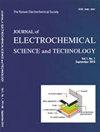Size Effects of MoS2 on Hydrogen and Oxygen Evolution Reaction
IF 3
4区 工程技术
Q3 ELECTROCHEMISTRY
Journal of electrochemical science and technology
Pub Date : 2021-10-27
DOI:10.33961/jecst.2021.00710
引用次数: 7
Abstract
Molybdenum disulfide (MoS 2 ) has been widely used as a catalyst for the bifunctional activities of hydrogen and oxygen evolution reactions (HER and OER). Here, we investigated size dependent HER and OER performance of MoS 2 . The smallest size (90 nm) of MoS 2 exhibits the lowest overpotential of -0.28 V at -10 mAcm -2 and 1.52 V at 300 mAcm -2 with the smallest Tafel slopes of 151 and 176 mVdec -1 for HER and OER, respectively, compared to bigger sizes (2 µm and 6 µm) of MoS 2 . The better HER and OER performance is attributed to high electrochemical active surface area (6 × 10 -4 cm 2 ) with edge sites and low charge transfer resistance (18.1 Ω), confirming that the smaller MoS 2 nanosheets have the better catalytic behavior.二硫化钼尺寸对析氢、析氧反应的影响
二硫化钼(MoS 2)已被广泛用作氢析氧反应(HER和OER)双官能团活性的催化剂。在这里,我们研究了大小对MoS 2的HER和OER性能的影响。与较大尺寸(2µm和6µm)的MoS 2相比,最小尺寸(90 nm)的MoS 2在-10 mAcm -2和300 mAcm -2下的过电位最低,分别为-0.28 V和1.52 V, HER和OER的Tafel斜率最小,分别为151和176 mVdec -1。较好的HER和OER性能归因于高电化学活性表面积(6 × 10 -4 cm 2)和低电荷转移电阻(18.1 Ω),证实了较小的MoS 2纳米片具有更好的催化行为。
本文章由计算机程序翻译,如有差异,请以英文原文为准。
求助全文
约1分钟内获得全文
求助全文
来源期刊

Journal of electrochemical science and technology
ELECTROCHEMISTRY-
CiteScore
6.30
自引率
8.10%
发文量
44
期刊介绍:
Covering fields:
- Batteries and Energy Storage
- Biological Electrochemistry
- Corrosion Science and Technology
- Electroanalytical Chemistry and Sensor Technology
- Electrocatalysis
- Electrochemical Capacitors & Supercapcitors
- Electrochemical Engineering
- Electrodeposition and Surface Treatment
- Environmental Science and Technology
- Fuel Cells
- Material Electrochemistry
- Molecular Electrochemistry and Organic Electrochemistry
- Physical Electrochemistry
- Solar Energy Conversion and Photoelectrochemistry
 求助内容:
求助内容: 应助结果提醒方式:
应助结果提醒方式:


